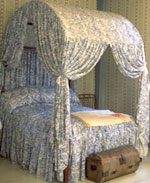At a Glance
Teacher Review
Topics
Features
Duration
Grade(s)
Lesson Format
Download
Messages of Houses and Their Contents, 1780-1820
Using images and other documents students compare the layout and furnishing of two early American homes to draw inferences about cultural and economic change in New England between 1780 and 1820.
Review

Personal possessions help us interpret the past, and this lesson encourages students to think about the "stuff" that people owned in early America. Students examine photographs of reconstructed rooms, inventories of possessions, and house layouts from different time periods and are asked to make inferences about how changes in common household possessions reflect broader changes in society. The lesson is made up of four one-hour activities, any one of which can stand on its own. In the first activity students compare two household inventories that list an individual's possessions and their value. One set of inventories is presented as original documents which give students a flavor of the spelling and penmanship of the time. Students are also given typed transcribed versions of the texts for easier (though still challenging) reading. The second and third activities focus on visual analysis. Students examine a series of photographs comparing rooms decorated according to styles between 1775 and the 1830s and floor plans of two homes. These images are excellent sources of evidence for the changes in consumer goods, fashion and technology that occurred in the early nineteenth century. A fourth (and in our opinion optional) activity focuses on changes in household gardens. All four activities are structured around discussion of differences that students are encouraged to notice in the images and artifacts. For homework, students write paragraphs about what changes in personal items may reveal about the past.
Notes
This lesson is the 10th of 15 lessons in a curriculum unit on Everyday Life in a New England Town created by Memorial Hall Museum in Deerfield, MA. Deerfield Museum presents an extensive online presence including interesting artifacts and educational activities. For this lesson teachers will need to project images from the website and/or download documents and make copies for their students.
| Field | Criteria | Comments | ||
|---|---|---|---|---|
| Historical Content | Is historically accurate? | Yes Documents and images are from the collection of Memorial Hall Museum. |
||
| Includes historical background? | Yes A background essay is included for teachers. Historical background for students is only included with the garden activity. |
|||
| Requires students to read and write? | Yes Students can read primary sources in original and/or transcribed versions. Homework requires writing. |
|||
| Analytic Thinking | Requires students to analyze or construct interpretations using evidence? | Yes Discussion questions focus on constructing interpretations using evidence. |
||
| Requires close reading and attention to source information? | Yes Requires close attention to visual detail and basic source information. |
|||
| Scaffolding | Is appropriate for stated audience? | Yes |
||
| Includes materials and strategies for scaffolding and supporting student thinking? | Yes Teachers are provided with specific questions to help students analyze the documents. A helpful guide to teaching using primary sources and a glossary of unfamiliar vocabulary and spelling is provided for teachers. Sharing these materials with students would be useful. |
|||
| Lesson Structure | Includes assessment criteria and strategies that focus on historical understanding? | No A written task assesses student learning but assessment criteria are absent. |
||
| Defines clear learning goals and progresses logically? | Yes Very clear goals and organization, however students may find the four activities repetitive. We recommend that teachers focus on activities one and two. |
|||
| Includes clear directions and is realistic in normal classroom settings? | Yes The lesson is easy to use and understand. Access to a computer that can project images to the whole class is desirable. |
|||